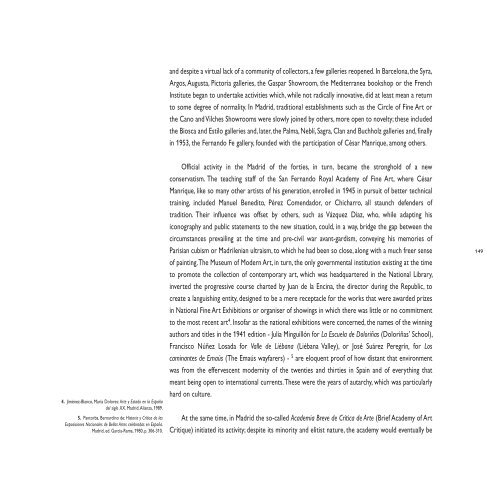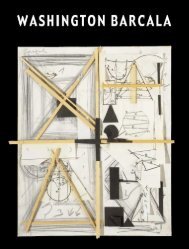VERSIÓN INGLESA ENGLISH VERSION - Fundación César Manrique
VERSIÓN INGLESA ENGLISH VERSION - Fundación César Manrique
VERSIÓN INGLESA ENGLISH VERSION - Fundación César Manrique
You also want an ePaper? Increase the reach of your titles
YUMPU automatically turns print PDFs into web optimized ePapers that Google loves.
4. Jiménez-Blanco, María Dolores: Arte y Estado en la España<br />
del siglo XX. Madrid, Alianza, 1989.<br />
5. Pantorba, Bernardino de: Historia y Crítica de las<br />
Exposiciones Nacionales de Bellas Artes celebradas en España.<br />
Madrid, ed. García-Rama, 1980, p. 306-310.<br />
and despite a virtual lack of a community of collectors, a few galleries reopened. In Barcelona, the Syra,<br />
Argos, Augusta, Pictoria galleries, the Gaspar Showroom, the Mediterranea bookshop or the French<br />
Institute began to undertake activities which, while not radically innovative, did at least mean a return<br />
to some degree of normality. In Madrid, traditional establishments such as the Circle of Fine Art or<br />
the Cano and Vilches Showrooms were slowly joined by others, more open to novelty; these included<br />
the Biosca and Estilo galleries and, later, the Palma, Neblí, Sagra, Clan and Buchholz galleries and, finally<br />
in 1953, the Fernando Fe gallery, founded with the participation of <strong>César</strong> <strong>Manrique</strong>, among others.<br />
Official activity in the Madrid of the forties, in turn, became the stronghold of a new<br />
conservatism. The teaching staff of the San Fernando Royal Academy of Fine Art, where <strong>César</strong><br />
<strong>Manrique</strong>, like so many other artists of his generation, enrolled in 1945 in pursuit of better technical<br />
training, included Manuel Benedito, Pérez Comendador, or Chicharro, all staunch defenders of<br />
tradition. Their influence was offset by others, such as Vázquez Díaz, who, while adapting his<br />
iconography and public statements to the new situation, could, in a way, bridge the gap between the<br />
circumstances prevailing at the time and pre-civil war avant-gardism, conveying his memories of<br />
Parisian cubism or Madrilenian ultraism, to which he had been so close, along with a much freer sense<br />
of painting. The Museum of Modern Art, in turn, the only governmental institution existing at the time<br />
to promote the collection of contemporary art, which was headquartered in the National Library,<br />
inverted the progressive course charted by Juan de la Encina, the director during the Republic, to<br />
create a languishing entity, designed to be a mere receptacle for the works that were awarded prizes<br />
in National Fine Art Exhibitions or organiser of showings in which there was little or no commitment<br />
to the most recent art 4 . Insofar as the national exhibitions were concerned, the names of the winning<br />
authors and titles in the 1941 edition - Julia Minguillón for La Escuela de Doloriñas (Doloriñas’ School),<br />
Francisco Núñez Losada for Valle de Liébana (Liébana Valley), or José Suárez Peregrín, for Los<br />
caminantes de Emaús (The Emaús wayfarers) - 5 are eloquent proof of how distant that environment<br />
was from the effervescent modernity of the twenties and thirties in Spain and of everything that<br />
meant being open to international currents. These were the years of autarchy, which was particularly<br />
hard on culture.<br />
At the same time, in Madrid the so-called Academia Breve de Crítica de Arte (Brief Academy of Art<br />
Critique) initiated its activity; despite its minority and elitist nature, the academy would eventually be<br />
149
















![Becas y premios de la Fundación César Manrique [1997-2006]](https://img.yumpu.com/20766851/1/184x260/becas-y-premios-de-la-fundacion-cesar-manrique-1997-2006.jpg?quality=85)
